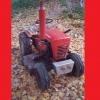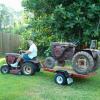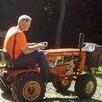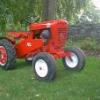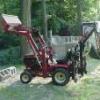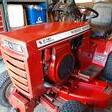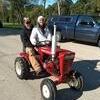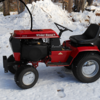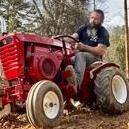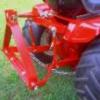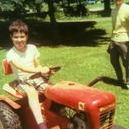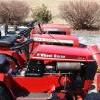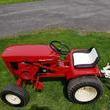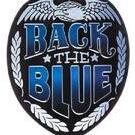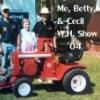Leaderboard
-
in all areas
- All areas
- Markers
- Marker Comments
- Marker Reviews
- Articles
- Article Comments
- Article Reviews
- Classfieds
- Classified Comments
- Classified Reviews
- Wiki's
- Wiki Comments
- Wiki Reviews
- Blog Entries
- Blog Comments
- Images
- Image Comments
- Image Reviews
- Albums
- Album Comments
- Album Reviews
- Files
- File Comments
- File Reviews
- Posts
-
Week
-
All time
November 28 2011 - April 20 2024
-
Year
April 20 2023 - April 20 2024
-
Month
March 20 2024 - April 20 2024
-
Week
April 13 2024 - April 20 2024
-
Today
April 20 2024
- Custom Date
-
All time
Popular Content
Showing content with the highest reputation since 04/13/2024 in all areas
-
30 pointsI have wanted to make this post for the past ten months; today I drove a Wheel Horse for the first time since my stroke! My wife was a bit apprehensive about the whole thing and I wasn't even sure I could get on the 310-8; but I did and it felt SOOOOOO GOOOOOOD
-
27 pointsAs of February I'm officially an "empty nester". After a long search my son & his fiance' finally found a house that fit their needs. He had mentioned to to his Mother that "I think I'm going to need a Wheel Horse to mow the lawn", her reply was "I think your Dad can spare one". LOL. So I'm starting him out on the same model & deck I started out on in 1979, one of my C-81's with a 36" RD deck. I've had her ready to go for him for a while now & since the trailer was stiil hooked up from @Pullstart's plowday on Saturday, I decided Sunday was the day. All I can say is this was one of the greatest weekends of my life that I'll always rememember. Loaded up Delivered And yes, I'll give him a mule drive with a knob on it.
-
20 pointsA few years ago at @WHX?? plow day I lost my wallet in the field while plowing. Fact jokes are still made about that. To top that off, shortly there after I plowed my phone under while plowing at my brothers place. After these events, my wife requested that I either empty my pockets while plowing or plow in nothing but my under ware. My brother was planting his field today, he looked down & thought crap I dropped my phone. Well... he didn't drop his phone, he actually found the phone that I lost. Pretty sure if I put it in a bowel of rice and clean it up it should still work. Now if we could only find my wallet.
-
16 pointsFinally got time to lay some paint on my buddies 702 project, 3 coats of base and 3 of clear. Came out pretty decent for being 2 hoods welded together. By far the roughest hood I'd ever saved. There's a little dirt in it but what to you expect for an old garage lol
-
15 pointsAre we gonna have a new member with lots of repair questions and how to fix PO mods?
-
15 pointsEconomy Power King Economy Tractors were designed to be an affordable garden tractor which could be serviced by the owner. Simple straightforward construction utilizing readily available parts resulted in a machine that was dependable and easily maintained. Company founder James E. Turner had been a designer for the Red-E tractor company. He was the son-in-law of one of that company’s founders and in 1946 decided to strike-out on his own to build four wheeled garden tractors at his newly formed Engineering Products of Waukesha (EPW) company. The concept of utilizing off-the-shelf parts and subcontracting manufacturing of castings and machine parts was rather revolutionary at the time. EPW was designing and assembling the tractors while most of the expensive overhead for machining, casting, metal stamping and other costly processes was borne by the subcontractors. The first year was devoted to design and engineering of prototypes and very few tractors were sold. Early models had cable steering which was later replaced with chain steering and eventually a steering gear was utilized. Early units were not fancy, they were devoid of any sheetmetal and had a cast-iron seat without padding. They had a Wisconsin air-cooled single cylinder engine attached to a modified Crosley bell housing, clutch, and transmission. The transmission unit was modified by adding pulleys for belt power transfer. A modified Ford Model-A rear axle assembly with reduction gears at the axles, much like the Red-E tractors, was used as a final drive. The Economy tractor was tested at the University of Nebraska in 1952 under test number 483. Economy tractors also carried the names Power King, Country Squire and the Jim Dandy along the way. Country Squire Garden Tractors were built from 1951 to 1962 and sold by mail-order through magazine advertising and sales booths at state and county fairs. They were powered by 9HP Briggs & Stratton or Wisconsin 9.2 HP air cooled single cylinder engines. Jin Dandy joined the ranks in 1964 and a part of the Economy line of tractors through 1977 It was a bit smaller and more affordable than the Country Squire. The Jim Dandy could be equipped with 10, 12 or 14 horsepower engines. The larger Power King line also came along in in 1964 being offered in 10, 12, and 14 horsepower Kohler engines. In 1977 the Economy name went away and a new numbering designation using rear wheel size and horsepower to derive the model number. As an example, a 1612 has 16” rear rims and a 12-horsepower engine. Power King was sold to Support Services International in 1990 and production moved from Waukesha to Beaver Dam. Production continued until the late 1990s when Power King was sold again. Eventually the Power King assets were sold to Yazoo-Kees and production ended. Mission Manufacturing now owns the rights to Power King and supports the tractors. Country Squire 9 hp 30/48" deck 1951 – 1962 Jim Dandy 10HP 10 hp 48" deck 1964 - 1967 Jim Dandy 12HP 12 hp 48" deck 1965 - 1970 Jim Dandy 14HP 14 hp 36/48/60" deck 1968 - 1977 Power King 10HP 10 hp 48" deck 1964 - 1967 Power King 12HP 12 hp 36/48/60" deck 1965 - 1970 Power King 14HP 14 hp 36/48/60" deck 1968 - 1977 1212 12 hp 42" deck 1982 - 1990 1214 14 hp 42/48" deck 1988 - 1993 1217 17 hp 42" deck 1983 - 1987 1218 18 hp 42/48" deck 1988 - 1993 1218HV 18 hp 48/60" deck 1994 - 1999 1220HV 20 hp 48" deck 1997 - 1998 1612 12 hp 48/60" deck 1977 - 1983 1614 14 hp 48/60" deck 1977 - 1993 1616 16 hp 48/60" deck 1977 - 1983 1617 17 hp 48/60" deck 1984 - 1988 1618 18 hp 48/60" deck 1977 - 1983 1618 18 hp 48/60" deck 1988 - 1993 1618GV 18 hp 48/60" deck 1994 - 1999 1620 20 hp 48/60" deck 1989 - 1993 1620HV 20 hp 48/60" deck 1994 - 1999 2414 14 hp 48/60" deck 1977 - 1988 2416 16 hp 48/60" deck 1977 - 1983 2417 17 hp 48/60" deck 1984 - 1988 2418 18 hp 48/60" deck 1977 - 1983 2418 18 hp 48/60" deck 1988 - 1993 UT620 20 hp 48/60" deck 1989 - 1993 UT620HV 20 hp 48/60" deck 1994 - 1999
-
15 pointsSo Wednesday I am driving down my street and there is a huge pile of garbage at the curb. I had to stop and look. I picked out this coffee table. Thought it was kinda cool. Mid century modern stuff is getting hot. So I brought it home. I cleaned it all up and waxed it. Came out pretty good. If you Google you see people asking 400 - 1200 dollars for one. I knew I had good taste !! It's in my living room now. This morning I went to an estate sale I bought this old Waterloo tool chest, loading with everything inside of it for 15 bucks. Add in the one owner little Wheel Horse I picked up Thursday for 75 bucks I think I'm having a good week.
-
14 pointsMy neighbor is into old cars and just pulled in with this gem He found down in Md. Then he said he also had this in the bed of his truck. Said he brought it along in case I wanted it. Yep! Accepting all interest and info on it's ID.
-
14 pointsI was going to post this in the big show thread but since I’m not going I thought I should put it here. If there’s an interest I’ll definitely assist on getting it in the right hands to get it there. I’ve decided to try and find a good home for my 1960 Suburban 400. It needs to be taken to shows and the like and not sit in my barn with only a trip through the paths now and then. This was a surprise find on Ebay in Deland, FL. I never expected to find one so close to where we lived at the time. I did a complete nuts and bolts rebuild on it. Here’s the thread on it. Suburban 400 Find in Florida - Wheel Horse Tractors - RedSquare Wheel Horse Forum As you can see it’s not 100% original and was never intended to be. The footrests are 1961, the stack, the wheel studs and lugnuts, rear tires, kill switch and stainless hardware are notable deviations from the original. The engine wasn’t properly addressed in the thread. When I got it there was a K-91 with a tapered shaft and a welded on drive pulley on it. I was going to get that fixed up with a replacement crank and whatever but instead I picked up a good K-91 from a member here. It runs great and sounds cool through the stack. A few extra parts for the engine are included because I ended up with them. A NOS pre-wound recoil starter spring, a new sediment bowl, a bearing and a seal and a head gasket. Nothing is needed but I’d have no use for them so they might as well go with it. Also a 3-ring binder with manuals, parts lists, service bulletins, etc. The thread explains the transmission work done on down the new axles and NOS 3523 gear. It’s flawless. An extra pair of 83-2840 axle seals included. Just as a point of interest (at least to me and they are not included) this is the tractor that Terry used on the big show banner he so graciously made for supporters a few years ago. It was also on the signs that he had on his website. As I often do, I was browsing his site and spotted the sign. The first thing that caught my eye was the oversize rear tires. A closer inspection revealed that, sure enough, it was the banner picture with the background and stack photo shopped out. It was also prior to swapping the 60 footrests for the 61. Cool!
-
14 points
-
13 pointsHello All!! Long time no checking in but, THANK YOU ALL for the birthday wishes last month. Appreciate the acknowledgement of the day I was hatched 45 years ago. After finally getting time to be off work early today the opportunity to get the C125 out of it's hibernation since early 83-84. And the story of what exactly happened to it. How I wish Paul Harvey (September 4, 1918 - February 28, 2009) could do this narrative for me. Here is the rest of the story. Bill had two sons, Neil and Patrick. Neil being the oldest was tasked with the lawn work with their father and Patrick being 3 years younger, could help by raking, picking up sticks and trimming with hand shears. One day, the family was heading to Peoria and on the way, passed by the local lawn and garden dealer. Seeing a load of the new black hood tractors outside on display he pulled in and didn't hesitate to purchase a C125, the first Wheel Horse sold at Stoekers Lawn and Garden. Also, his first garden tractor. The tractor was delivered on a Friday afternoon and the salesman demonstrated how to operate it safely to Neil and his father. After taking turns on mowing the lawn, it was parked in the garage. Patrick wanted a turn but his father told him that he can use the push mower for a few years first and then graduate to the rider. Not the answer he wanted. Then came Sunday, the day of relaxing, family picnic and the accident. After church, they all raced home, mother busy with the prep of the drinks, salads and desserts, father cleaning the grill and placing tables in the shade with the help of both sons. That afternoon, people were enjoying their Sunday lunches and conversations when the sound of a motor got the attention of the father. A Wheel Horse had come out of the garage with Patrick driving... poorly at top speed. He managed to strike the concrete flower planter, picnic table with people, dessert table, and a pine tree. Needless to say, tractor was ruined and so was the picnic. I found out that the father had tried to repair/repaint the hood to the best of his ability but couldn't get it the way he wanted. So, instead of selling, or trading it off he decided to bury it in the back of his shed behind the many vending machines to be forgotten until a few months ago. His son Pat is the one who gave me this tractor and told me the entire history of why it was buried. The deal is that I maintain the lawn that tractor was intended for since he didn't get to. I installed a new battery and cleaned the fuel system. That's all! Runs beautiful, drives excellent, needs hood repainted and decals. Needs the Choke handle since it was broken off. Thinking about using plasma cutter and eliminating the discharge chute unless the deck from my 312 will fit. Have to get the C195 out for pictures from small to large
-
13 pointsNo visuals of Dan plowing in his skivvies Sylvia? No but the wallet sprouted...
-
13 points
-
12 pointsMy son brought over his 1969 Work Horse 700 and together we showed it done attention. New rear AG’s. New adjustable tie rods and a front end alignment, also replaced the steering thingy that bolts to each frame rail (can’t think of the name). That part was a PIA!! He also brought over the 42” deck off his 314-8 so we could use my air gun to get his mowing blades swapped. Great day!
-
12 pointsOn 4-4-24 the Winter storm left 14'' of heavy wet snow and shut down the complete 1.5 mile loop of trails the RS members enjoy at the September M & G every year. This does not include the dirt woods road not owned by us that is about a 4 mile out and back that Mike @Sparky takes charge of is impassable currently as well. At this time all of the trails are done on the house side of the brook. The trails on half of the Cabin side of the brook are done except the far left hand side of the property where the Hemlock grove is which is about 5 ac. This is the worst we have seen this much of a mess here after a Winter storm. I have been able to have a good friend of mine come up 3 times to help out with getting things back to normal. I have done quite a bit of it alone picking a little bit each day. Having well maintained equipment around has made a huge difference in the progress. I would like to thank @AMC RULES and @Mrs. Rules for the offer to drive all the way up here to lend a hand so the M&G will continue on, very much appreciated. That is what makes RS a special place. These pictures are only some of what it looks like and I may have posted more than I should have not to bore anyone. Thanks All
-
12 points
-
12 pointsWorking with help from a friend on the mount for the mid-blade so it’ll have lift, rotation, and roll (tilt). He has a Hyster with long forks. It makes me nervous having it so high up there but dang is it convenient to get under to work on! Upper and lower grader frame parts coming along. Tomorrow the main parts should be together and then onto final design and implementation of the controls.
-
12 points
-
12 pointsFor the first time in a long long time the “twins” were both out doing yard work. I worked this morning and then came home to do some yard work. I try to base my timing of my yard work (thatching, aerating, fertilizing, etc) on when we do it at work. We started a couple weeks ago at work but it seems like every weekend it’s rained and kept me from doing it. Sure enough it poured twice while I was out. I only did the front yard and part of the side. The back which is the biggest piece of the property can wait. The twins are my 71 Bronco 14 and my 73 12 automatic. Both with 18hp vanguard v twins so that’s why we call them the twins. The 12 auto pulled the green thatcher (don’t hurt me gotta use what I have) and the bronco was on the vac system. Alex isn’t home this weekend. It definitely felt weird being able to drive a couple tractors of my own and do work with them. He usually jumps to do it as soon as I mention anything tractor work related.
-
11 pointsI threw together this puller to remove that last stubborn pin that I had. First I used a Sawzall to cut the pin on each side of the tranny. Then I drilled & tapped the pin that was stuck in the tranny. After that I used this puller to remove the pin. Tighten the bolt on the puller, use a drift to pound on the opposite end of the pin. Repeat, repeat, add more extensions, repeat....
-
11 points
-
11 pointsWell I've always wanted to plant sweet corn and this year I'm giving it a try. So this will be a small garden size, 12x30'. I'm doing 4 rows 30" apart, seed spacing about 8-10". Started off with the moldboard plow, then the disc harrow which didn't work as good as I hoped but soil was probably a bit moist for it, the cultivator worked great and I did most of the work with that to level and break up the soil, then used it to make the rows. Next time I'll probably borrow my friends WH tiller to prep the soil. So planted 11 days ago and already have sprouts coming up. I'm using Milorganite for my nitrogen feed. A couple observations from a first timer using the WH in the garden, first the turf tires on the front of the rig are not good at all for working a garden. It was all over the place and I had a hard time holding a line. Thinking I'll try a 4.00-8 pneumatic tire of some kind in the future or something similar. Any suggestions for a front tire and wheel combo would be appreciated, tractor is a 312-8. Will add a little weight to the front as well with the front 2" receiver next time. I would like advice for critter control and specifically with raccoons if anyone has some to offer. The creek behind my yard is full of them and they will be an issue at some point. I've seen the scent stuff you can put around the perimeter and the solar powered stuff on Amazon, also considering a small electric fence on a timer. Any advice would be appreciated! Now for pics!
-
11 pointsExcept that MTD will look like trash and not “art” ! Nothing wrong with letting one retire. I clear-coated this one to stop it from rusting away. As you can tell I love showing it off as much as my running driving machines !!
-
11 pointsChampion Machine Company When International Harvester was being formed by Cyrus McCormick Jr. and William Deering, they sought out partnerships or purchases of competing harvester companies to corner the harvester market. Champion Machine was a very attractive buy because they had an established dealer network in twelve states & Europe, an up-to-date manufacturing plant and over a hundred patents. William N Whiteley founded the Champion Reaper and Mower Works in Springfield, Ohio in 1855. In the late 1800s and early 1900s it was commonplace to have equipment dealers stage field trials to show-off the quality of their wares. At age 22 Whitley entered a local trial of reaping machines and demonstrated his new machine in the field. Champion was in direct competition with Warder, Bushnell, Glessner, & Co. who also made mowers. The two companies eventually merged soon becoming the largest manufactories of its type in the nation. Springfield became known as the “Champion City” and a few of Champion’s subcontractors also took on the Champion name, The Champion Bar & Knife Co. and The Champion Malleable Iron Foundry also located in Springfield. I don’t know if this is fact or fable but this was too good to pass-up. William. N. Whiteley was quite a character according to some of the stories told about him. He was supposed to be a large ox of a man, a great salesman, and a bit of a hot head. It’s said at one time he was demonstrating a reaper with a competitor in the field with him. Not wanting to be shown up he unhitched one of the horses in his team and went on across the field with a single horse. The competitor not wanting to lose any sales did the same which really set Whitely off. Whitely unhitched the last horse and proclaimed I can pull the reaper myself. He unhitched the second horse and proceeded to pull the reaper across the field himself. Champion Machine Company was bursting at the seams and built a new state-of-the-art factory complex of over a million square feet in 1884. Now all of Champion’s processes were under one roof, raw materials came in the back door and finished reapers, mowers and rakes went out the front door to be shipped to eager customers. By 1887 Champion was one of the most profitable companies in the United States with sales of over four million dollars. (Over 130 million in 2024 dollars) Champion was one of the companies bought out with the formation of International Harvester in 1902 however, the Champion Line continued to be sold. All production moved to the Chicago IH factory and in 1908, the company marked a major milestone: sale of its 2,000,000th Champion machine. Albert Krell, of the Krell-French Piano Company, purchased and remodeled the Champion factory in preparation to begin production of pianos when the factory went up in flames on Feb. 10, 1902.
-
11 pointsFlywheel Horse came out of the winter stables and pulled yard duty!
-
11 pointsA big thanks to @PWL216 for bringing this to me. This'll be a future project for the BBT and me. The numbers show it to be a 1974. The engine has been replaced. Unfortunately the serial/spec number isn't legible. The engine appears to be blue...ish (?)
-
11 pointsProbably gonna wear out my welcome with this machine, but I have a serious crush on this tractor.
-
11 points
-
11 pointsWhat have I done to "my" Wheelhorse? Brought it somewhere else! Here's my Ole Man in his purple hat driving the C121 we built for him to mow with.
-
10 points*** If your name is in RED you can play*** Well some guys were complaining about already having too many cups so I figured I would do something else. I bought a small hobby laser last year and have been trying to come up with Wheel Horse related items I could make. Not a ton of stuff out there, especially personalized. So with that said, I had come across a simple design for a phone charging stand and decided to try it out. Works great with my phone, even in a case. It’s right at 6” tall and 3.5” wide. When the phone isn’t there, whatever design is on it shows. So I am going to randomly pick two people and they can choose what they want on it. Just post your name here and this coming Saturday I will draw two numbers. One post please so I can keep up with it. Thanks for supporting my favorite website on the net and thanks to Karl & the admin team for all they do.
-
10 pointsGalloway Farmobile Tractor and much more William Galloway became successful by providing what the customer wanted and making the purchase a pleasure. He learned customer service as a door to door salesman after graduation from collage and working as a traveling sales representative for farm implements. With the lessons learned on the rural roads of Iowa, Galloway began a farm implement dealership in Waterloo Iowa in 1901 and looked for opportunities to meet the needs of his customers. Within a couple of years, he was manufacturing his own line of harrows, carts wagons, and manure spreaders. Soon the product line expanded to include gasoline engines, cream separators, tractors, and other implement specialties. When William Galloway decided to get into the engine business in 1906 he bought an established business, the first Galloway engines were built by a Wisconsin firm, but beginning in 1908 they were built in the Waterloo factory. Galloway built its “Frostfree” line of water-cooled engines in sizes from 1-3/4 to 15 hp along with a 1-3/4 hp air-cooled model. All engines were available as stationary or portable (on wheeled trucks) versions. Prices in 1913 ranged from $29.75 for a 1-3/4 hp air-cooled to $439.50 for a 15 hp portable. (frostfree means the water-cooling tank could be drainer easily) The William Galloway Company had outgrown its manufacturing facility after six years and moved to a new fourteen-acre floor space building in 1907. He was providing employment for over eight hundred people and had sales of two million dollars. Galloway’s sales catalog business provided serious competition to companies such as Sears & Roebuck at that time. The majority of Galloway’s sales were mail order from his catalog with over three hundred thousand customers. Since he had a strong catalog customer base Galloway added household items. The 1913 catalog featured 146-pages of engines, pumps, sawing outfits, manure spreaders, cream separators, portable elevators and well drilling outfits. There were litter carriers, incubators and brooders; sprayers, grain drills and corn planters; plows, harrows and cultivators; harness, saddles and buggies, as well as Galloway wagons, which were famous for their high quality. Also, anvils, forges, iceboxes, mattresses, roofing, work clothes, windmills, and almost anything the farmer could imagine. You could even buy the Little Wonder Vodaphone, tennis rackets, roller skates, and even bicycles through the Galloway catalogs. Since most customers for farm implements traveled to Waterloo Iowa to pick-up their purchases Galloway built a rooming house known as the Galloway Club where customers could eat and sleep for free. Galloway expanded his product line in 1908 to include manufacturing a vehicle promoted as a conveyance that could carry the family to church on Sunday and haul cargo during the week. Power for the rather basic high wheeled car was a two-cylinder, fourteen-horse power engine. One advertisement made a comparison between owning a Galloway Auto Transport to owning a horse , telling prospective customers it was a waste of money to feed horses “… corn worth 75 cents a day and oats worth 35 to 40 cents, and hay worth $14 to $20 a ton …” when they could buy “Galloway’s New Auto Transport,” which “Puts Town Next Door to Your Farm for less than $36 a Year.” The 1910 acquisition of the Maytag-Mason Motor Car Company gave Galloway a much more acceptable car. The Maytag-Mason Automobile was powered by a two-cylinder engine designed by Fred and August Duesenberg. This is the same Maytag that produced gas engines for agricultural machinery and washing machines and the same Duesenberg brothers that went on to produce some of America’s most presages automobiles. Agricultural equipment sales remained strong and were so profitable that it allowed Galloway to make further ventures intro the motor vehicle manufacturing arena. The Dart Truck and Tractor Company was brought into the Galloway family in 1910. These were well engineered machines with chain drive which were update The “Farmobile” tractor was Galloway’s entry into the farm tractor market. The 12-20 model powered by a Dart four-cylinder liquid cooled engine with a two-speed transmission was featured in their catalog for $ 995 and promotion claimed that the Galloway manufactured tractor “Pulls Anything, Anywhere, Anytime.” Having a line of trucks and a tractor to pull the Galloway farm implements made them a full line manufacturer. The October 17, 1918 edition of Automotive Industries noted that “the new worm drive tractors produced three years of experimentation.” The article also states that “…in January of this year the company received an order for 1,080 tractors of this type from the well–known British firm of Henry Garner, Ltd.” The future looked very promising for Galloway with increasing sales of Farmobile Tractors and Dart trucks. A new smaller general purpose Bearcat tractor was being added to the line and the company needed to expand its manufacturing facility to accommodate the growth. Galloway decided to sell corporate bonds to generate funding for the Dart Truck manufacturing facility. Volume 99, Bankers Magazine, 1919, “One of the largest bond issues ever handled by Iowa banks has been underwritten and sold by the Waterloo Clearing House Association without the assistance of either Wall Street or LaSalle Street interests. This was the $1,750,000 issue of the William Galloway Company of Waterloo, Iowa, hearing date of July 1, 1919, and due July 1, 1925. Both are a direct obligation of the William Galloway Company and are a lien against its plant, properties, and business.” The agricultural depression that followed World War Two and the recently generated debt load were insurmountable for Galloway and the firm went out of business in 1921. William Galloway’s sons resurrected the company in late 1926, but on a much more modest scale. As a mail-order company for farm supplies. A 1939 catalog lists cream separators, manure spreaders, harrows, gas engines, feed grinders and hammer mills, wagons, barn equipment, poultry equipment, and paint. No further information was found past 1939.
-
10 pointsOld classmate does yard clean up and excavation. He cleaned out a barn for a family of a deceased Allis Chalmers collector. They gave him all of this and he asked me if I wanted it as he had no idea what to do with it. Stuff has been sitting a while but everything spins and moves. A B212 and 2 712 hydros with a sickle, mid grader, snow blower, garden scratcher, 2 decks, dozer blade and the remnants of a snow cab. I may have a buyer lined up for all of it already!
-
10 pointsGive your Garden Tractor a Lift In June of 1969 Popular Science Magazine encouraged us to “Give your Garden Tractor a Lift”. They provided detailed drawings and a good description of the build. Let’s get in our time travel machine and go back fifty-five years to build this hand powered forklift attachment.
-
10 points
-
10 points
-
10 points
-
10 pointsThe C-81 had mulch duty yesterday & today after work, she still has @Pullstart's cornfield mud on her feet.
-
10 pointsMidwest Utilitor The Midwest Engine Company of Indianapolis, Ind., began making a walk behind tractor prior to 1920 called the Midwest Utilitor which was powered by a one-cylinder, 4-cycle, water cooled Midwest Engine. The Utilitor had two steel lugged drive wheels and a pair of rear dolly wheels and weighed 750 pounds. It had steering clutches to aid in turning and a weight between the handlebars to compensate for the heavy engine forward of the drive wheels. A full array of plows and cultivators was available. Also available was a two-gang disc harrow, with four disc blades on each gang, an Acme blade-type pulverizing harrow, a 3-row garden seeder, a spring tine cultivator, and an adapter for hitching a 3 1/2 foot one-horse mower. Many of the images in their advertising featured women operating the walk-behind tractor, others were aimed at potential dealers to sell the tractors. Like so many other companies Midwest Engines suffered in the Great Depression. By 1929, the tractor was being manufactured by a Utilitor company that was in Dayton, Ohio. Toward the end of the depression the Utilitor General-Purpose four-wheel tractors joined the two-wheel version with the new Dayton OH address. indicates that the company moved or was acquired. No conclusive information could be found. Midwest Engine Company supplied power for several manufacturers including Lauson Tractors of New Holstein, WI. Lauson made tractors from 1926 until 1929. Production ceased when the Great Depression started, and Lauson did not get paid for many of their tractors. Electric generators were also built by Midwest which were very important to rural America in the late 1920s.
-
10 pointsThanks to @WHX?? this 1267 went from WI to PA! Saw it on Facebook several months ago and asked Jim if he was closeby and he was indeed. After some intersting interactions with the seller it finally went to his house. I believe he started a thread on that. Anyway, he took it to pullstarts plowday and I went out to get at his place in michigan. I'm super pumped to have this sweet machine in my collection! Chaged all the fluids tonight. Good thing too cause the crankcase was full of gas! It was probably because of a bad float jim fixed, but I rebuilt the fuel pump too for good measure.
-
10 pointsMy rookie mistakes have been replaced with elder-error. Getting ready to load up for the Wheel Horse, I was so happy at how the K-161 on my 701 started instantly. As you know, the 701 has no parking brake, so there it was, sitting in 1st gear to keep it from rolling away from the ramp of my trailer. I turned the key, pushed the starter button, and you guessed it, there she went, riderless, up the ramp.
-
10 points
-
10 pointsI wasn’t finished plowing, though my friends left! I made a few passes on Justin (Case) with the 8” plow I ran behind Putt Putt yesterday. It worked best in 1st gear, but still worked!
-
10 points
-
9 points
-
9 pointsI did the same with my son back in 2019… 310-8 with a deck (and eventually a plow).
-
9 pointsPicked up a machine the other day. Was just thinking parts tractor, but when we unloaded it, thought it was a good idea to see if it turned over. Hooked up the jump pack and it rolled over real nice. Oh, since it turned lets shoot a little juice in the carb and check for fire. It lit up on the juice and sounded pretty good. And then it hit me. It sucked all that bad gas and water from the bottom of the tank into the carb. Nice going Joe! I typically take off the fuel hose and check the quality of the fuel etc. and install an IV tank with clean filtered fuel. Note to self: THINK! Fuel Sample
-
9 pointsSpeaking of painting! Painted the rims for my C-175 restoration today, actually I prepped them and my brother painted them. Primed with a good epoxy primer, then sanded a lot!! Brought a decent rim with good factory paint to the hardware store and matched it up with an oil base Benjamin Moore linen white. I’m super happy with the results.
-
9 pointsFarm Ette Garden Tractor When the Tom Moore Tractor Company, Mantua, OH, began marketing the Farm-Ette line of lawn and garden equipment they were attempting to serve all markets. The had some unique offerings with one, two, three or four wheels. Also, there was “Triger-Tach Power-Pak.” The Triger-Tach Power-Pak consisted of a detachable handle/engine package that could be attached to a variety of lawn and garden implements. It had a Briggs & Stratton 2 ¼ horse power air cooled engine with a recoil starter. You could select the “Garden Tractor which was a two wheeled framework that attachments could be connected to. You could select 18-inch cultivators, a 6-inch turning plow, a set of 5-inch disks, a 24-inch snow plow or a 24-inch spreader. Other units that could be propelled by the Power-Pack an 18-inch Reel Mower, 20-inch Rotary Mower or a 16-inch Tiller. The Model 22 lawn tractor is very cute, probably not too functional, but cute! The two small rear wheels are mounted to steerable casters and the somewhat larger front wheel is the drive wheel. The one wheeled Model B was primarily a cultivator but could also push a 20-inch snow plow, 21-inch reel mower or power a 36-inch sickle bar mower. The Farm Ette Model C was a conventional two wheeled walk-behind garden tractor available in two horsepower and three and a half horsepower sizes. The four wheeled Model 75 riding garden tractor was powered by a Lauson 5.5 hp engine and had a three-speed transmission. One unique attachment that would be very useful, the Cary-All. Our own @VinsRJ produced this video
-
9 points
-
9 pointsRed-E Tractor Red-E Tractors were produced by Pioneer Manufacturing Company which was founded on March 19, 1922 by Earl Welbourne, William J. Meyer, James A. Mould and John Buday in Milwaukee, Wisconsin. Its focus was farm machinery and began in West Allis, Wisconsin (1922-1946) then moved to Richfield, Wisconsin in 1946. Earl Welbourn, a professor of Mechanical Engineering at Marquette University in Milwaukee, Wisconsin, took an interest in a concept tractor built by a student of his. It’s not known if the student got an A for his project but Professor Welbourne must have been impressed. His first two wheeled walking tractor was built in 1918 and served as the model for the first Red-E steel wheeled walk-behind tractor. "Universal Red-E Power Cultivators" could be configured with many different implements including plows, cultivators, discs, S & H set onion planters, Nash Acme harrow, seeders, drags, spike harrows, furrower with wings, orchard style front fenders, wheel hoes, Iron King wire seeders, many cuts of different cultivator shovels, various wheels, sprayers, snow blade, Type T-22 Red-E mower, type T7-60 Red-E gang mower with riding seat, riding roller, and much more. Pioneer Manufacturing built their own engines but used abundantly available Ford Model “T” pistons, connecting rods, intake and exhaust valves, and the Model “T” Holley carburetors. The engine crank case casting included the tractor’s transmission. The air-cooled single cylinder sleeve and head was bolted to the base casting with an air shroud fitted over the cylinder and the top of the transmission casting. The flywheel had fins cast into it which drew air through the shroud cooling the cylinder head. This same style engine was used on all cast engine/transmission tractors until they were phased out in the 1950s. In 1942 six models of garden tractors were offered, five models of the cast engine/transmission configuration RED-E tractors including models 11 and 12 as well as the 11R and a 12R which offered forward and reverse. New additions were the model ZA-5A steel wheeled tractor and the ZA-7A with rubber tires. All models came with standard cultivator attachments and the new 5A and 7A came with Briggs and Straton one and two horse-power air cooled engines. By 1945 changes were occurring at RED-E tractor. The cast models 11 and 12 now had pipe handles instead of wooden plow handles. The factory was relocated to Richfield, Wisconsin, and started producing an entirely new line of tractor. While cast models 11 and 12 were still being manufactured at Richfield, they were being phased out in favor of four wheeled riding garden tractors. The Page Dairy and Farm Equipment Co. of Milwaukee had been in the Garden tractor manufacturing business since 1926 and had developed a rear engine four wheeled riding garden tractor that was of interest to Pioneer Manufacturing. The Page tractor portion of the company was purchased by Pioneer in 1949. By 1951 the four-wheel riding tractor had gone from the rear engine Page design to a front engine model. It is believed that the four-wheel garden tractors were sold under the Page and Red-E names. James E. Turner, the son-in-law of founding partner Earl Welbourne, worked for the Pioneer Manufacturing Company as a designer. In 1946 he left the company to begin work on a four wheeled garden tractor that would use easily obtained automotive parts. This tractor, the Economy, was manufactured by Mr. Turner’s company, Engineering Products of Waukesha, Wisconsin. Much like the Pioneer manufactured units his tractor was also based on simplicity of use and ease of repair. The unit had a Wisconsin air-cooled single cylinder engine. It was attached to a modified Crosley bell housing and transmission. The transmission unit was modified by adding pulleys for belt power transfer. A modified Ford Model-A rear axle assembly with reduction gears at the axles was used as a final drive. The Economy tractor was tested at the University of Nebraska in 1952 under test number 483. In 1964 the Economy name was replaced becoming known as the Power King, it was also known as the Country Squire and the Jim Dandy along the way. More about that tomorrow. During the many years it built tractors, RED-E Tractor Company and Pioneer Manufacturing Company always strived to make a simple quality product that could easily be repaired or modified to suit its owner’s needs. Production of Red-E tractors ended in 1962. @oldiron613 posted some good information about the Pioneer/Page/Economy lineage in the attached post.
This leaderboard is set to New York/GMT-04:00

